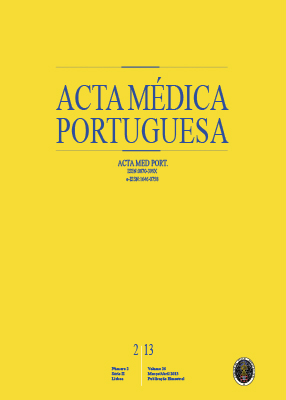Hypofractionation in Locally Advanced Breast Cancer: “Flash” Scheme
DOI:
https://doi.org/10.20344/amp.4096Abstract
Introduction: Breast cancer is a major cause of death in our country. The Department of Radiation Oncology of Portuguese Institute of Oncology in Coimbra are using a scheme of hypofraccionation called “Flash” as a treatment option for elderly patients or low performance status, with locally advanced breast cancer, or with stage IIb or IV, as a neoadjuvante or palliative aim. Objectives: Evaluation of the therapeutic response, for the group of patients selected, who did the hypofractionated schemed, in a retrospective study. Methods: Between January 2006 and December 2008, a total of 83 patients diagnosed with locally advanced breast cancer or with stage IIb or IV, were subjected to breast “Flash”. The radiation dose prescribed was 13Gy in 2 fractions in 3 days (in 23 patients – 27.7%) and 26 Gy in 4 fractions in 5 weeks (60 patients – 72.3%), with 4MV photons, in the sick breast. Global survival was evaluated using the Kaplan-Meier method. Statistical analysis was performed by applying the version 17.0 of SPSS and statistical tests were evaluated at a significance level of 5%. Results: 80 patients (96.4%) who have made breast “Flash” were female, aged between 59 and 93 years and performance status (Karnosfky scale) between 90 and 50%. In 72 patients (86.7%) the histology was invasive ductal carcinoma. Surgery was held in 53% of patients (44) after breast “Flash”, the radical modified mastectomy was the most common surgical technique. The diagnosis of bone metastasis was made in 10 patients (12%), while the global survival rate was 68.7% (57 patients). 10 patients (12%) died because disease progression or persistence. In 50.6% (42 patients) there was no evidence of disease progression and 3.6% (3 patients) showed clinical improvement. Conclusions: The “Breast Flash” is a safe treatment modality, in terms of secondary effects, and a valid therapeutic option for elderly patients or low performance status, with the diagnosis of locally advanced cancer or stage IIb or IV, as neoadjuvante, adjuvant or palliative aim. There is a little risk of relapse or progression in patients with good conditions, so the global survival rate is greater in these cases. There is a little iatrogenesis associated with this type of treatment; just one patient had grade III radiodermatitis.
Downloads
Downloads
How to Cite
Issue
Section
License
All the articles published in the AMP are open access and comply with the requirements of funding agencies or academic institutions. The AMP is governed by the terms of the Creative Commons ‘Attribution – Non-Commercial Use - (CC-BY-NC)’ license, regarding the use by third parties.
It is the author’s responsibility to obtain approval for the reproduction of figures, tables, etc. from other publications.
Upon acceptance of an article for publication, the authors will be asked to complete the ICMJE “Copyright Liability and Copyright Sharing Statement “(http://www.actamedicaportuguesa.com/info/AMP-NormasPublicacao.pdf) and the “Declaration of Potential Conflicts of Interest” (http:// www.icmje.org/conflicts-of-interest). An e-mail will be sent to the corresponding author to acknowledge receipt of the manuscript.
After publication, the authors are authorised to make their articles available in repositories of their institutions of origin, as long as they always mention where they were published and according to the Creative Commons license.









